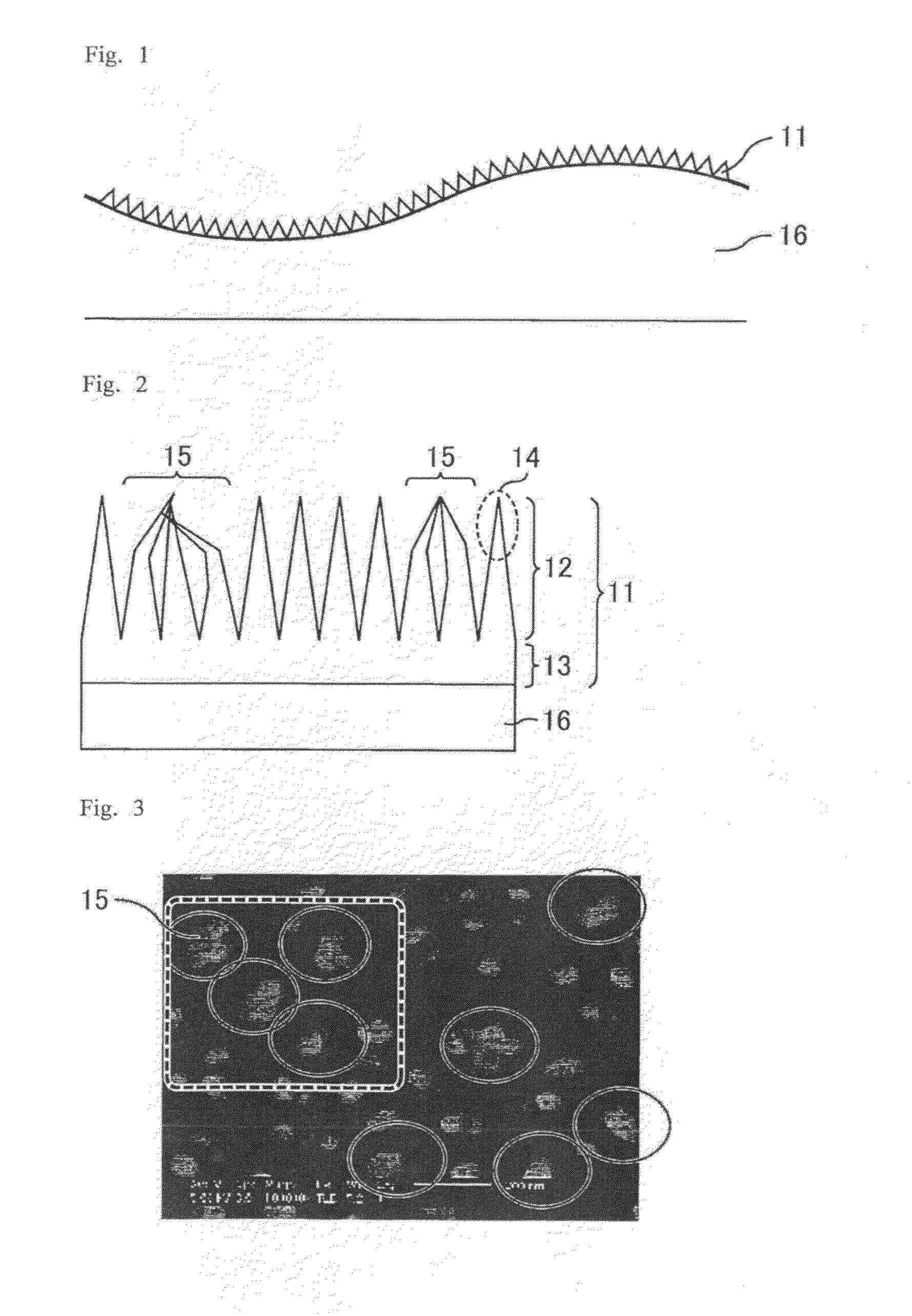Antireflection film, method for manufacturing antireflection film, and display apparatus
a technology of anti-reflection film and anti-reflection film, which is applied in the direction of identification means, instruments, other domestic objects, etc., can solve the problems of insufficient reflection prevention effect, difficult-to-see display, and insufficient reflected light beam removal. achieve the effect of low reflection
- Summary
- Abstract
- Description
- Claims
- Application Information
AI Technical Summary
Benefits of technology
Problems solved by technology
Method used
Image
Examples
embodiment 1
[0077]FIGS. 1 and 2 each are a schematic cross-sectional view of the moth-eye film (antireflection film) of Embodiment 1. FIG. 1 is an overall view and FIG. 2 is an enlarged view. As shown in FIGS. 1 and 2, a moth-eye film 11 of Embodiment 1 is disposed on a substrate 16 which is the target of antireflection treatment. The substrate 16 to be the target of antireflection treatment may be a member constituting the outermost surface of a display device, such as a polarizer, acryl protecting plate, or hard coat layer disposed on the surface of a polarizer.
[0078]As shown in FIG. 1, the moth-eye film 11 has a structure that multiple fine projections are arranged on its surface. Each of the projections is tapered toward the tip. The surface of the substrate 16 has an uneven structure with a gentler incline than the fine projections, and the surface of the moth-eye film 11 also has a corresponding gentle uneven structure. The surface of the substrate 16 is formed by the AG treatment. The di...
embodiment 2
[0098]The moth-eye film of Embodiment 2 is different from the moth-eye film of Embodiment 1 in that the material resin of the moth-eye film is different; however, the film of Embodiment 2 is the same as that of Embodiment 1 in the other respects. The following will describe the method for producing the moth-eye film of Embodiment 2 referring to Examples 5 and 6 wherein a moth-eye film was actually produced.
[0099]FIG. 19 is a plan photograph of the moth-eye film produced in Example 5 and FIG. 20 is a schematic view of the portion outlined by the dotted line in FIG. 19. In addition, FIG. 21 is a plan photograph of the moth-eye film produced in Example 6 and FIG. 22 is a schematic view of the portion outlined by the dotted line in FIG. 21. The steps in Examples 5 and 6 are substantially the same as those in Example 2, but they are different from those in Example 2 in that a resin material is not one to be cured at 2 J / cm2 but one to be cured at 6 J / cm2. The moth-eye film produced in Ex...
embodiment 3
[0102]The moth-eye film of Embodiment 3 is different from the moth-eye films of Embodiments 1 and 2 in that the surface of the moth-eye film is wet-wiped after applying ultraviolet rays to the resin layer to cure the layer; however, the film is the same as those in Embodiments 1 and 2 in the other respects. The following will describe the method for producing the moth-eye film of Embodiment 3 referring to Example 7 wherein a moth-eye film is actually produced.
[0103]FIGS. 23 to 28 are plan photographs of the moth-eye film produced in Example 7 and schematic views of the portion outlined by the dotted line in the corresponding photograph. FIGS. 23 and 24 are before wet-wiping, while FIGS. 25 to 28 are after wet-wiping. Of FIGS. 25 to 28, FIGS. 25 and 26 are not-enlarged views, while FIGS. 27 and 28 are enlarged views. The steps in Example 7 are substantially the same as those in Example 6, but they are different from those in Example 6 in that wet-wiping was performed using pure-water...
PUM
| Property | Measurement | Unit |
|---|---|---|
| diameter | aaaaa | aaaaa |
| diameter | aaaaa | aaaaa |
| aspect ratio | aaaaa | aaaaa |
Abstract
Description
Claims
Application Information
 Login to View More
Login to View More - R&D
- Intellectual Property
- Life Sciences
- Materials
- Tech Scout
- Unparalleled Data Quality
- Higher Quality Content
- 60% Fewer Hallucinations
Browse by: Latest US Patents, China's latest patents, Technical Efficacy Thesaurus, Application Domain, Technology Topic, Popular Technical Reports.
© 2025 PatSnap. All rights reserved.Legal|Privacy policy|Modern Slavery Act Transparency Statement|Sitemap|About US| Contact US: help@patsnap.com



